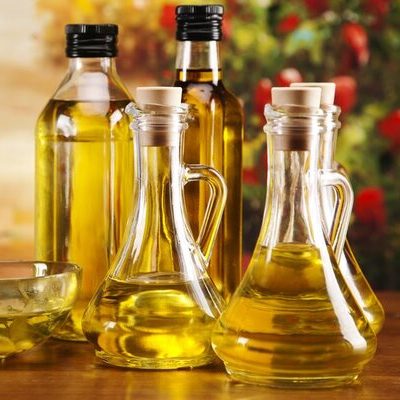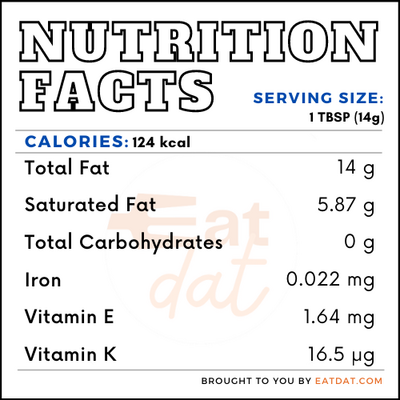
Oil
What is Oil?
Oil is a fatty, greasy substance derived from plants or animals. This substance is used in the frying, baking, and steaming of foods but can also be a vital ingredient. Most are liquid at room temperature but some contain high levels of fats and can also become solid when the temperature is low.
- Different cultures utilize them in traditional cuisine, depending on the local source used for producing the oil.
- They can be used in preparing dishes like pickled vegetables, dressing for salads, or even baked goods.
There are many different types of oils, including:
- Coconut
- Olive
- Avocado
- Ghee
- Pumpkin Seed
- Walnut
- Grapeseed
- Peanut
- Sesame
- Hemp Seed
- Flaxseed
- Sunflower
- Canola
- Mustard
- Vegetable
Origin of oil
Cooking oils are one of the first developments in human cuisine. They were first discovered when humans began to cook meat on fires, and the animal fats dripped out. Depending on what was available, early humans began the process to obtain oils for different purposes, including cooking, around 250,000 years ago. This was done by using some source of heat, such as the sun or a fire, to heat the plant products to exude fat. Some varieties are of recent origin, as waste products, like seeds, are now used to produce this.
Nutrition
One tablespoon (14g) of vegetable oil contains:

Cooking oils have fatty acids that can be grouped into three classes:
- saturated fatty acids (SFA)
- monounsaturated fatty acids (MUFA)
- polyunsaturated fatty acids (PUFA)
Different varieties contain these elements in different proportions. Oils with SFA are considered harmful as they can increase LDL, which is the bad cholesterol. However, PUFA and MUFA varieties are credited with lowering the risk of LDL and cardiovascular diseases. Refined varieties have high trans fatty acids, which may lead to higher cardiological risks. Some of the healthiest options include coconut, flaxseed, olive, mustard, rice bran, safflower, sesame, and canola (rapeseed).
Commercial production
To produce oil, seeds, nuts, and other raw materials are pressed through mechanical extraction, resulting in expeller pressed oil. Then, they are chemically processed to squeeze out the last vestiges left in the raw material. Cold pressed oil is pressed at a temperature lower than 120°F, resulting in a product that is healthier and more nutritious, keeping both the flavors and micronutrients from the raw material. RBD (refined, bleached, and deodorized) varieties are generally tasteless, odorless, and colorless, irrespective of the raw material used. In these varieties, the fatty acids are neutralized and the phospholipids are removed. These are useful for deep frying.
The global market is dominated by palm oil, followed by soybean, canola, and sunflower seed oil. China is the largest producer of this substance in the world, followed by the European Union, India, the USA, Indonesia, Brazil, Malaysia, Pakistan, Argentina, and Russia.
Oil recipes
Different varieties of oil offer different properties, textures, and flavors, making them suitable for an array of dishes. Some varieties, such as sesame, pumpkin seed, and avocado may be used beyond the kitchen. Here are a few popular recipes to try:
- Spaghetti Aglio e Olio
- Banana Chips
- Mbanga Soup
- Aloo Chokha
- Sesame Noodles
- Flavored Herbal Oils
- Wild Mushroom and Walnut Oil Salad
- Avocado Oil Mayonnaise
- Chicken Satay
FDA regulations
Vegetable oil is governed by the USDA, which defines its grades and standards, quality, packaging, and distribution. Also, the USDA regulates the olive oil grades and defines it as the oil obtained solely from the fruit of the olive tree.
References
Processing Edible Oils, Penn State Extension, College of Agricultural Sciences, The Pennsylvania State University, https://extension.psu.edu/processing-edible-oils
Manchanda, S C, and Santosh Jain Passi. “Selecting healthy edible oil in the Indian context.” Indian heart journal vol. 68,4 (2016): 447-9. doi:10.1016/j.ihj.2016.05.004, https://www.ncbi.nlm.nih.gov/pmc/articles/PMC4990724
Schwingshackl, Lukas et al. “Effects of oils and solid fats on blood lipids: a systematic review and network meta-analysis.” Journal of lipid research vol. 59,9 (2018): 1771-1782. doi:10.1194/jlr.P085522, https://www.ncbi.nlm.nih.gov/pmc/articles/PMC6121943/
